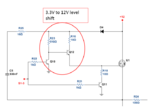sghr220
Junior Member level 3
Hi all,
I am in the process of designing a DC to 220v AC / 50 Hz pure sine-wave inverter which is very unoriginal of course :smile:.
Thanks to Tahmid's blog and all the great threads in this forum i collected a wealth of information about this application. Having some unanswered questions, i hope you can help me with them so here we go...
The transformer i am planning to use is a 50 Hz iron core which doesn't have a center tap so i have to use either a half-bridge or a full bridge configuration. The bridge is to be constructed using N-Mosfet's so we have a high and low sides.
Some photos from Tahmid's blog...

The push-bull configuration is the simplest in driving and requires a few transistors to implement but it also requires a center tapped transformer (and also there is the efficiency limitations).

The full-bridge configuration is also pretty straight forward but requires double the number of transistors to achieve a certain output power.

And here is the half-bridge circuit which has (i guess) the best of both worlds less transistors and no center tap required but i can't quite understand the operation of the circuit and what are the function of the two 330uF capacitors connected to the second coil terminal?
I am not using a HV bus in this inverter, the battery voltage is fed to the transformer driving circuit directly. The battery voltage can be 12v, 24v, 36v and 48 volts according to the inverter output power in order to get some reasonable battery current and not several hundreds of amps that will fry the battery in the shortest time frame. :smile:
Another question will be the ratio of the transformer, my basic understanding is that for a single 12v battery we need a 12-0-12 center-tapped transformer or a 0-12 transformer, but in some of the circuit i see a 8-0-8 and 10-0-10 transformers used to produce a 220v output why is that? and is the ratio of the transformer dependent on the inverter output waveform? and if so how to calculate the ratio for a modified sine-wave inverter and for a pure sine-wave inverter fed from a 12v battery?
I am in the process of designing a DC to 220v AC / 50 Hz pure sine-wave inverter which is very unoriginal of course :smile:.
Thanks to Tahmid's blog and all the great threads in this forum i collected a wealth of information about this application. Having some unanswered questions, i hope you can help me with them so here we go...
The transformer i am planning to use is a 50 Hz iron core which doesn't have a center tap so i have to use either a half-bridge or a full bridge configuration. The bridge is to be constructed using N-Mosfet's so we have a high and low sides.
Some photos from Tahmid's blog...

The push-bull configuration is the simplest in driving and requires a few transistors to implement but it also requires a center tapped transformer (and also there is the efficiency limitations).

The full-bridge configuration is also pretty straight forward but requires double the number of transistors to achieve a certain output power.

And here is the half-bridge circuit which has (i guess) the best of both worlds less transistors and no center tap required but i can't quite understand the operation of the circuit and what are the function of the two 330uF capacitors connected to the second coil terminal?
I am not using a HV bus in this inverter, the battery voltage is fed to the transformer driving circuit directly. The battery voltage can be 12v, 24v, 36v and 48 volts according to the inverter output power in order to get some reasonable battery current and not several hundreds of amps that will fry the battery in the shortest time frame. :smile:
Another question will be the ratio of the transformer, my basic understanding is that for a single 12v battery we need a 12-0-12 center-tapped transformer or a 0-12 transformer, but in some of the circuit i see a 8-0-8 and 10-0-10 transformers used to produce a 220v output why is that? and is the ratio of the transformer dependent on the inverter output waveform? and if so how to calculate the ratio for a modified sine-wave inverter and for a pure sine-wave inverter fed from a 12v battery?

